Standardized Procedures for Osteoporosis Treatment: A Nursing Policy
VerifiedAdded on 2023/04/21
|13
|3251
|431
Report
AI Summary
This report provides a comprehensive overview of standardized procedures for nurses in the treatment of osteoporosis. It begins by establishing the significance of osteoporosis as a widespread health issue and emphasizes the need for organized healthcare systems to develop standardized protocols. The report details the general policies set by the Board of Nursing, focusing on collaboration with the Allied Health Professions division and adherence to specific guidelines for nurses performing tasks without direct physician supervision. Key aspects covered include the development, review, and scope of standardized procedures, educational qualifications for nurse practitioners, and the importance of ongoing competency evaluation. Furthermore, it addresses consultation processes, patient record maintenance, and a detailed protocol definition of osteoporosis, including its epidemiology, causes, history, symptoms, and diagnostic tests. The report concludes with a thorough discussion of disease management strategies, encompassing bone mineral density studies, non-pharmacologic therapies, lifestyle interventions, and pharmacological treatments, highlighting the role of medications in stabilizing and enhancing bone mineral density.
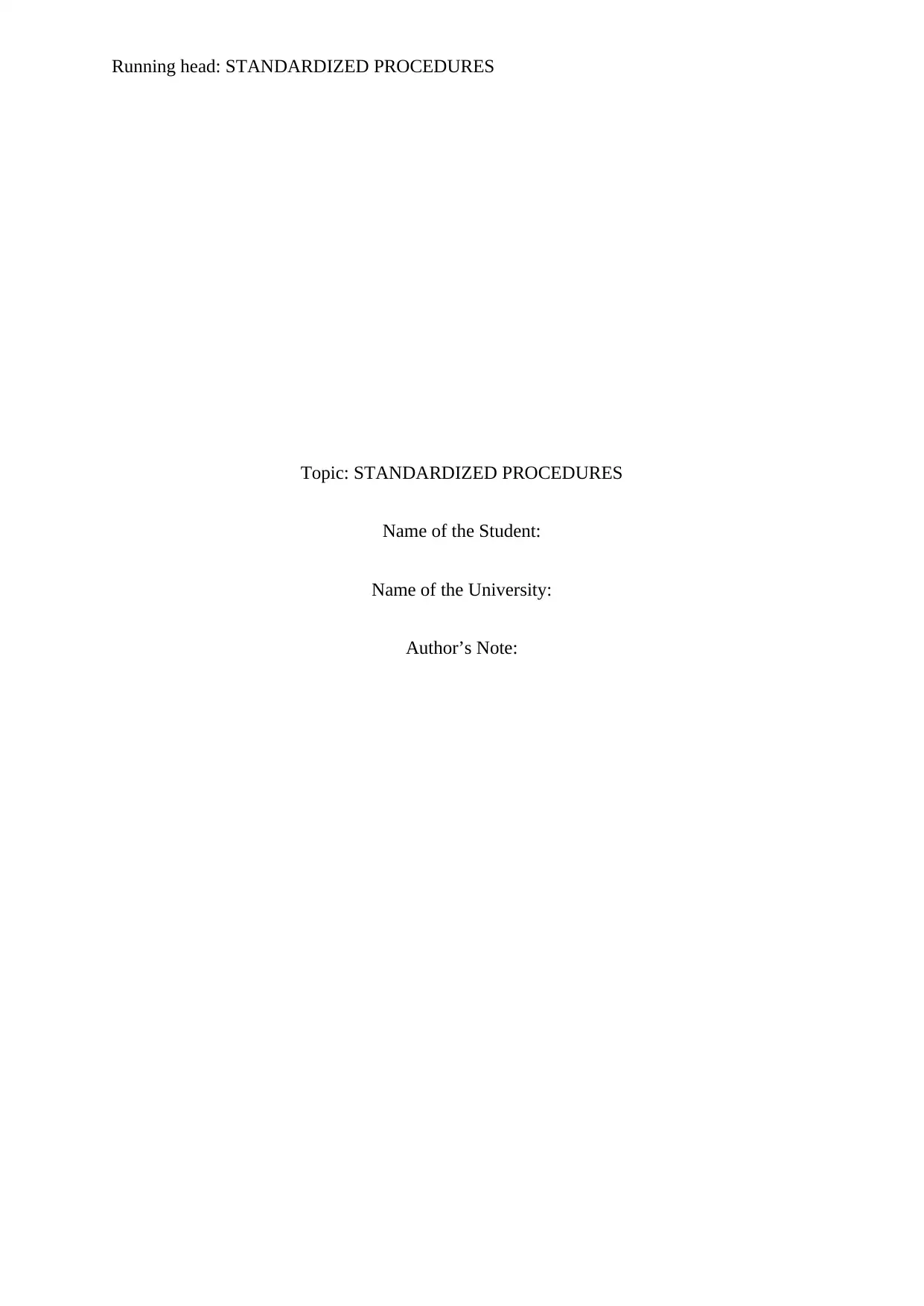
Running head: STANDARDIZED PROCEDURES
Topic: STANDARDIZED PROCEDURES
Name of the Student:
Name of the University:
Author’s Note:
Topic: STANDARDIZED PROCEDURES
Name of the Student:
Name of the University:
Author’s Note:
Paraphrase This Document
Need a fresh take? Get an instant paraphrase of this document with our AI Paraphraser
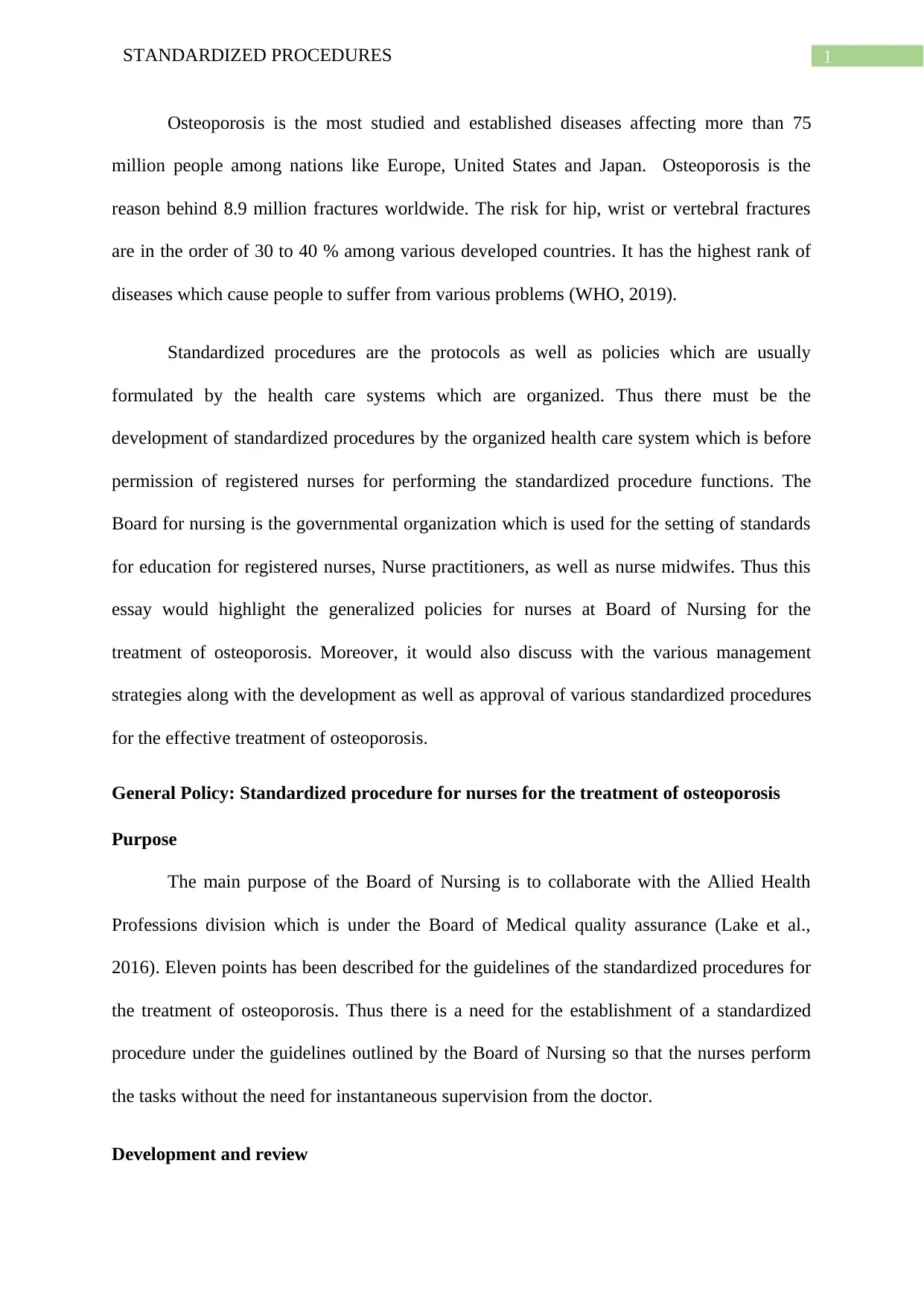
1STANDARDIZED PROCEDURES
Osteoporosis is the most studied and established diseases affecting more than 75
million people among nations like Europe, United States and Japan. Osteoporosis is the
reason behind 8.9 million fractures worldwide. The risk for hip, wrist or vertebral fractures
are in the order of 30 to 40 % among various developed countries. It has the highest rank of
diseases which cause people to suffer from various problems (WHO, 2019).
Standardized procedures are the protocols as well as policies which are usually
formulated by the health care systems which are organized. Thus there must be the
development of standardized procedures by the organized health care system which is before
permission of registered nurses for performing the standardized procedure functions. The
Board for nursing is the governmental organization which is used for the setting of standards
for education for registered nurses, Nurse practitioners, as well as nurse midwifes. Thus this
essay would highlight the generalized policies for nurses at Board of Nursing for the
treatment of osteoporosis. Moreover, it would also discuss with the various management
strategies along with the development as well as approval of various standardized procedures
for the effective treatment of osteoporosis.
General Policy: Standardized procedure for nurses for the treatment of osteoporosis
Purpose
The main purpose of the Board of Nursing is to collaborate with the Allied Health
Professions division which is under the Board of Medical quality assurance (Lake et al.,
2016). Eleven points has been described for the guidelines of the standardized procedures for
the treatment of osteoporosis. Thus there is a need for the establishment of a standardized
procedure under the guidelines outlined by the Board of Nursing so that the nurses perform
the tasks without the need for instantaneous supervision from the doctor.
Development and review
Osteoporosis is the most studied and established diseases affecting more than 75
million people among nations like Europe, United States and Japan. Osteoporosis is the
reason behind 8.9 million fractures worldwide. The risk for hip, wrist or vertebral fractures
are in the order of 30 to 40 % among various developed countries. It has the highest rank of
diseases which cause people to suffer from various problems (WHO, 2019).
Standardized procedures are the protocols as well as policies which are usually
formulated by the health care systems which are organized. Thus there must be the
development of standardized procedures by the organized health care system which is before
permission of registered nurses for performing the standardized procedure functions. The
Board for nursing is the governmental organization which is used for the setting of standards
for education for registered nurses, Nurse practitioners, as well as nurse midwifes. Thus this
essay would highlight the generalized policies for nurses at Board of Nursing for the
treatment of osteoporosis. Moreover, it would also discuss with the various management
strategies along with the development as well as approval of various standardized procedures
for the effective treatment of osteoporosis.
General Policy: Standardized procedure for nurses for the treatment of osteoporosis
Purpose
The main purpose of the Board of Nursing is to collaborate with the Allied Health
Professions division which is under the Board of Medical quality assurance (Lake et al.,
2016). Eleven points has been described for the guidelines of the standardized procedures for
the treatment of osteoporosis. Thus there is a need for the establishment of a standardized
procedure under the guidelines outlined by the Board of Nursing so that the nurses perform
the tasks without the need for instantaneous supervision from the doctor.
Development and review

2STANDARDIZED PROCEDURES
All the standardized procedures are usually developed by the Interdisciplinary Committee
after collaboration and approval by them. The membership of the Interdisciplinary practice
committee consists of nurses, physicians, practitioners as well as administrators. They should
conform to the 11 steps of the standardized procedures and the guidelines which are specified
in title 16 in the CCR section 1474.
All the various standardized procedures should be maintained in a manual which is inclusive
of the dates the signed approval sheets including the persons covered by standardized
procedures.
The various standardize procedures should be reviewed through an interval of 3 years as well
as practiced by the IDPC.
Moreover all the changes and the additions to various standardized procedures should be
approved by and accompanied by dated as well as signed sheets of approval.
Scope and setting of the NP
Nurses might perform various functions within their training specialty area as well as
consistency pertaining to their experience as well as credentialing. The various processes
involved in the credentialing is management, assessment as well as treatment of various
chronic illness, contraception as well as common nursing functions of cases pertaining to
health promotion as well as general evaluation of health status. This includes processes like X
rays, laboratory procedures, physical therapies as well as recommending diets and referring
specialty clinics when indicated.
Various function of standardized procedures like management of medication regimens
should be performed like short appointed clinics. Nurses consulting physicians through
person or through telephone is necessary for the process. Consultation of the protocols should
be there for the individual protocols as well as during the following circumstances when there
are emergent conditions which require the promptness of the medical interventions especially
after initial stabilization of care. Moreover, problems which do not get resolved as
anticipated, acute decompensation of the situation of the patient, inconsistent lab findings,
All the standardized procedures are usually developed by the Interdisciplinary Committee
after collaboration and approval by them. The membership of the Interdisciplinary practice
committee consists of nurses, physicians, practitioners as well as administrators. They should
conform to the 11 steps of the standardized procedures and the guidelines which are specified
in title 16 in the CCR section 1474.
All the various standardized procedures should be maintained in a manual which is inclusive
of the dates the signed approval sheets including the persons covered by standardized
procedures.
The various standardize procedures should be reviewed through an interval of 3 years as well
as practiced by the IDPC.
Moreover all the changes and the additions to various standardized procedures should be
approved by and accompanied by dated as well as signed sheets of approval.
Scope and setting of the NP
Nurses might perform various functions within their training specialty area as well as
consistency pertaining to their experience as well as credentialing. The various processes
involved in the credentialing is management, assessment as well as treatment of various
chronic illness, contraception as well as common nursing functions of cases pertaining to
health promotion as well as general evaluation of health status. This includes processes like X
rays, laboratory procedures, physical therapies as well as recommending diets and referring
specialty clinics when indicated.
Various function of standardized procedures like management of medication regimens
should be performed like short appointed clinics. Nurses consulting physicians through
person or through telephone is necessary for the process. Consultation of the protocols should
be there for the individual protocols as well as during the following circumstances when there
are emergent conditions which require the promptness of the medical interventions especially
after initial stabilization of care. Moreover, problems which do not get resolved as
anticipated, acute decompensation of the situation of the patient, inconsistent lab findings,
⊘ This is a preview!⊘
Do you want full access?
Subscribe today to unlock all pages.

Trusted by 1+ million students worldwide

3STANDARDIZED PROCEDURES
physical, history within the practical setting pertaining to clinical procedures are to be
considered. Moreover, the nurses should involve the opinion of the supervising physician, as
well as the patient before consulting the physician.
Educational qualifications of the NP
Nurses performing the various functions of standardized procedures should have
current California nursing license as a registered nurse. Moreover, the nurse should be a
graduate of any Nurse practitioner program. She should also have the certification of a
qualified nurse practitioner by the BRN or California Board of Nursing (Au et al., 2016).
There should be proper evaluation of the competence of the nurse’s performance
involving the standardized procedures and its functions. The evaluation should be done in
three stages, initial stage where evaluation of the nurse will occur at intervals of 3,6 ,12
months by the nurse through the nurse manager . This evaluation would be done through
physicians, colleagues, as well as chart reviews which occurs during performance during the
evaluation. Moreover, it should be followed by the routine period where evaluation will be
done annually after first year. This will be done by the manager through the feedback form
which occurs through physicians and colleagues.
Supervision and evaluation
General competency is one of the most important factors to be considered while
evaluation. It is generally evaluated through the probationary period especially through a
proctoring process through the supervising physician (Shin et al., 2015). The registered nurse
is supervised as well as assigned by a physician whose main responsibility is the annual
evaluation of the appropriateness of the practice and the clinical decision-making. A quality
analysis process is usually established for assuring that there are the standards which relates
to the importance of the various aspects of care which are maintained.
physical, history within the practical setting pertaining to clinical procedures are to be
considered. Moreover, the nurses should involve the opinion of the supervising physician, as
well as the patient before consulting the physician.
Educational qualifications of the NP
Nurses performing the various functions of standardized procedures should have
current California nursing license as a registered nurse. Moreover, the nurse should be a
graduate of any Nurse practitioner program. She should also have the certification of a
qualified nurse practitioner by the BRN or California Board of Nursing (Au et al., 2016).
There should be proper evaluation of the competence of the nurse’s performance
involving the standardized procedures and its functions. The evaluation should be done in
three stages, initial stage where evaluation of the nurse will occur at intervals of 3,6 ,12
months by the nurse through the nurse manager . This evaluation would be done through
physicians, colleagues, as well as chart reviews which occurs during performance during the
evaluation. Moreover, it should be followed by the routine period where evaluation will be
done annually after first year. This will be done by the manager through the feedback form
which occurs through physicians and colleagues.
Supervision and evaluation
General competency is one of the most important factors to be considered while
evaluation. It is generally evaluated through the probationary period especially through a
proctoring process through the supervising physician (Shin et al., 2015). The registered nurse
is supervised as well as assigned by a physician whose main responsibility is the annual
evaluation of the appropriateness of the practice and the clinical decision-making. A quality
analysis process is usually established for assuring that there are the standards which relates
to the importance of the various aspects of care which are maintained.
Paraphrase This Document
Need a fresh take? Get an instant paraphrase of this document with our AI Paraphraser

4STANDARDIZED PROCEDURES
Consultation in the standardized procedures
Proper consultation from the physician is one of the most important factors to be
considered for the diagnosis of the planned as well as approved standardized procedure.
Moreover, collaboration with the stake holders inclusive of the hospital organization is
important for the maintenance for the standardized procedure (Rn.ca.gov, 2019).
Patient Records
Maintenance of the records of the patients is very important for considering issues like
confidentiality breaches. The information of the patient’s health should be documented
properly by the various nurse practitioners through the use of systems like Electronic medical
record (EMR) (Halpern et al., 2016).
Apart from the EHR or electronic health records, the nurses should follow the guidelines
of the various standardized procedures. Regional health Information Organization (RHIO) is
the solution for the proper collection of data for the information of the patient (Lei et al.,
2017).
Protocol
Definition
The literal meaning of osteoporosis is porous bones. Thus it is a disease where the
bones usually become weaker which increases the risk of the fracture especially in the wrist
spinal vertebrae. Usually there is high bone density during the age of 20. Around 35 years the
bones start to decay causing osteoporosis due to the faster degradation of the bones than the
usual rate. Furthermore, it has been found through extensive research that people having
recent osteoporotic fracture have the general probability of the increase in the number of
fractures (Black & Rosen, 2016).
Consultation in the standardized procedures
Proper consultation from the physician is one of the most important factors to be
considered for the diagnosis of the planned as well as approved standardized procedure.
Moreover, collaboration with the stake holders inclusive of the hospital organization is
important for the maintenance for the standardized procedure (Rn.ca.gov, 2019).
Patient Records
Maintenance of the records of the patients is very important for considering issues like
confidentiality breaches. The information of the patient’s health should be documented
properly by the various nurse practitioners through the use of systems like Electronic medical
record (EMR) (Halpern et al., 2016).
Apart from the EHR or electronic health records, the nurses should follow the guidelines
of the various standardized procedures. Regional health Information Organization (RHIO) is
the solution for the proper collection of data for the information of the patient (Lei et al.,
2017).
Protocol
Definition
The literal meaning of osteoporosis is porous bones. Thus it is a disease where the
bones usually become weaker which increases the risk of the fracture especially in the wrist
spinal vertebrae. Usually there is high bone density during the age of 20. Around 35 years the
bones start to decay causing osteoporosis due to the faster degradation of the bones than the
usual rate. Furthermore, it has been found through extensive research that people having
recent osteoporotic fracture have the general probability of the increase in the number of
fractures (Black & Rosen, 2016).
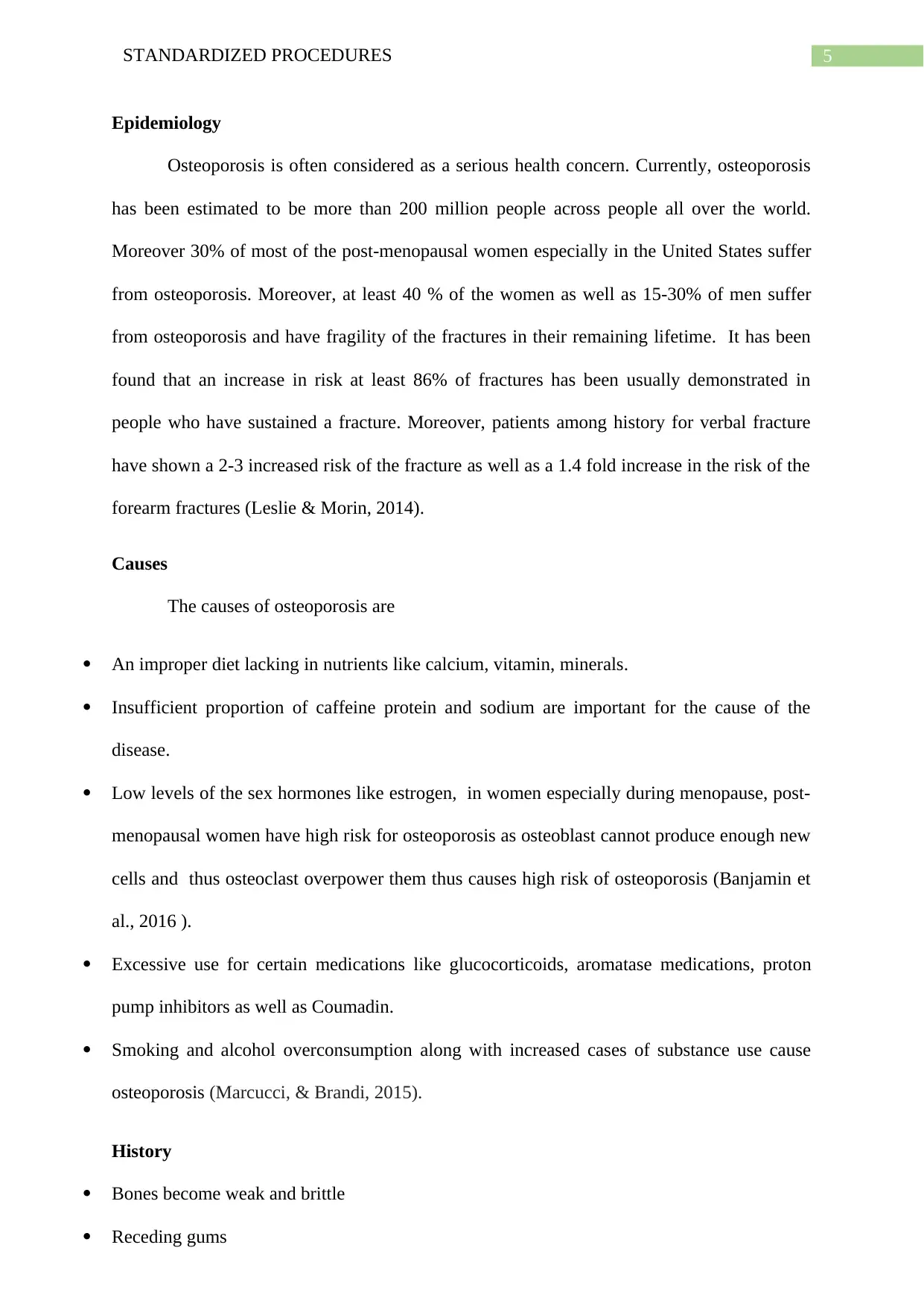
5STANDARDIZED PROCEDURES
Epidemiology
Osteoporosis is often considered as a serious health concern. Currently, osteoporosis
has been estimated to be more than 200 million people across people all over the world.
Moreover 30% of most of the post-menopausal women especially in the United States suffer
from osteoporosis. Moreover, at least 40 % of the women as well as 15-30% of men suffer
from osteoporosis and have fragility of the fractures in their remaining lifetime. It has been
found that an increase in risk at least 86% of fractures has been usually demonstrated in
people who have sustained a fracture. Moreover, patients among history for verbal fracture
have shown a 2-3 increased risk of the fracture as well as a 1.4 fold increase in the risk of the
forearm fractures (Leslie & Morin, 2014).
Causes
The causes of osteoporosis are
An improper diet lacking in nutrients like calcium, vitamin, minerals.
Insufficient proportion of caffeine protein and sodium are important for the cause of the
disease.
Low levels of the sex hormones like estrogen, in women especially during menopause, post-
menopausal women have high risk for osteoporosis as osteoblast cannot produce enough new
cells and thus osteoclast overpower them thus causes high risk of osteoporosis (Banjamin et
al., 2016 ).
Excessive use for certain medications like glucocorticoids, aromatase medications, proton
pump inhibitors as well as Coumadin.
Smoking and alcohol overconsumption along with increased cases of substance use cause
osteoporosis (Marcucci, & Brandi, 2015).
History
Bones become weak and brittle
Receding gums
Epidemiology
Osteoporosis is often considered as a serious health concern. Currently, osteoporosis
has been estimated to be more than 200 million people across people all over the world.
Moreover 30% of most of the post-menopausal women especially in the United States suffer
from osteoporosis. Moreover, at least 40 % of the women as well as 15-30% of men suffer
from osteoporosis and have fragility of the fractures in their remaining lifetime. It has been
found that an increase in risk at least 86% of fractures has been usually demonstrated in
people who have sustained a fracture. Moreover, patients among history for verbal fracture
have shown a 2-3 increased risk of the fracture as well as a 1.4 fold increase in the risk of the
forearm fractures (Leslie & Morin, 2014).
Causes
The causes of osteoporosis are
An improper diet lacking in nutrients like calcium, vitamin, minerals.
Insufficient proportion of caffeine protein and sodium are important for the cause of the
disease.
Low levels of the sex hormones like estrogen, in women especially during menopause, post-
menopausal women have high risk for osteoporosis as osteoblast cannot produce enough new
cells and thus osteoclast overpower them thus causes high risk of osteoporosis (Banjamin et
al., 2016 ).
Excessive use for certain medications like glucocorticoids, aromatase medications, proton
pump inhibitors as well as Coumadin.
Smoking and alcohol overconsumption along with increased cases of substance use cause
osteoporosis (Marcucci, & Brandi, 2015).
History
Bones become weak and brittle
Receding gums
⊘ This is a preview!⊘
Do you want full access?
Subscribe today to unlock all pages.

Trusted by 1+ million students worldwide
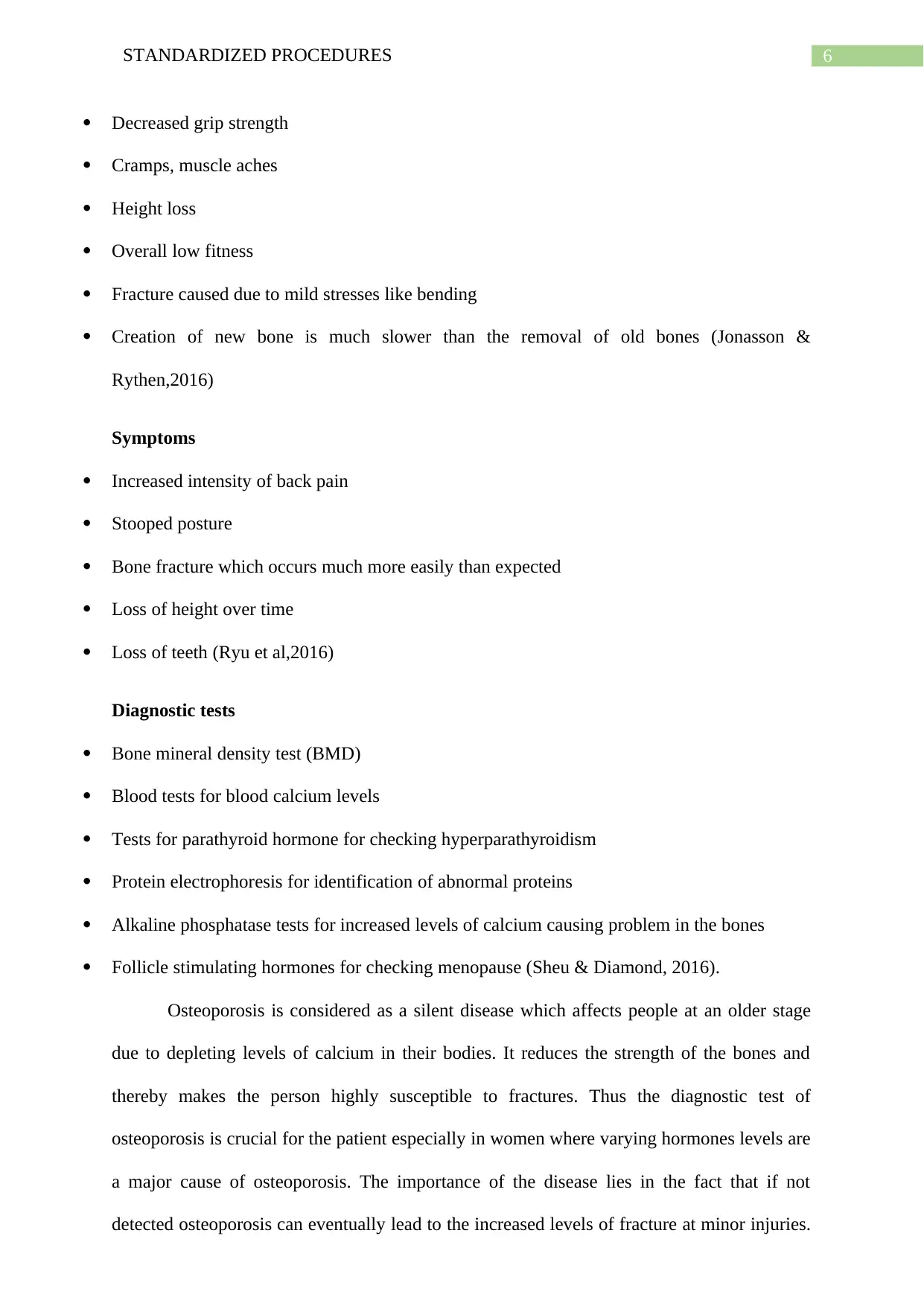
6STANDARDIZED PROCEDURES
Decreased grip strength
Cramps, muscle aches
Height loss
Overall low fitness
Fracture caused due to mild stresses like bending
Creation of new bone is much slower than the removal of old bones (Jonasson &
Rythen,2016)
Symptoms
Increased intensity of back pain
Stooped posture
Bone fracture which occurs much more easily than expected
Loss of height over time
Loss of teeth (Ryu et al,2016)
Diagnostic tests
Bone mineral density test (BMD)
Blood tests for blood calcium levels
Tests for parathyroid hormone for checking hyperparathyroidism
Protein electrophoresis for identification of abnormal proteins
Alkaline phosphatase tests for increased levels of calcium causing problem in the bones
Follicle stimulating hormones for checking menopause (Sheu & Diamond, 2016).
Osteoporosis is considered as a silent disease which affects people at an older stage
due to depleting levels of calcium in their bodies. It reduces the strength of the bones and
thereby makes the person highly susceptible to fractures. Thus the diagnostic test of
osteoporosis is crucial for the patient especially in women where varying hormones levels are
a major cause of osteoporosis. The importance of the disease lies in the fact that if not
detected osteoporosis can eventually lead to the increased levels of fracture at minor injuries.
Decreased grip strength
Cramps, muscle aches
Height loss
Overall low fitness
Fracture caused due to mild stresses like bending
Creation of new bone is much slower than the removal of old bones (Jonasson &
Rythen,2016)
Symptoms
Increased intensity of back pain
Stooped posture
Bone fracture which occurs much more easily than expected
Loss of height over time
Loss of teeth (Ryu et al,2016)
Diagnostic tests
Bone mineral density test (BMD)
Blood tests for blood calcium levels
Tests for parathyroid hormone for checking hyperparathyroidism
Protein electrophoresis for identification of abnormal proteins
Alkaline phosphatase tests for increased levels of calcium causing problem in the bones
Follicle stimulating hormones for checking menopause (Sheu & Diamond, 2016).
Osteoporosis is considered as a silent disease which affects people at an older stage
due to depleting levels of calcium in their bodies. It reduces the strength of the bones and
thereby makes the person highly susceptible to fractures. Thus the diagnostic test of
osteoporosis is crucial for the patient especially in women where varying hormones levels are
a major cause of osteoporosis. The importance of the disease lies in the fact that if not
detected osteoporosis can eventually lead to the increased levels of fracture at minor injuries.
Paraphrase This Document
Need a fresh take? Get an instant paraphrase of this document with our AI Paraphraser
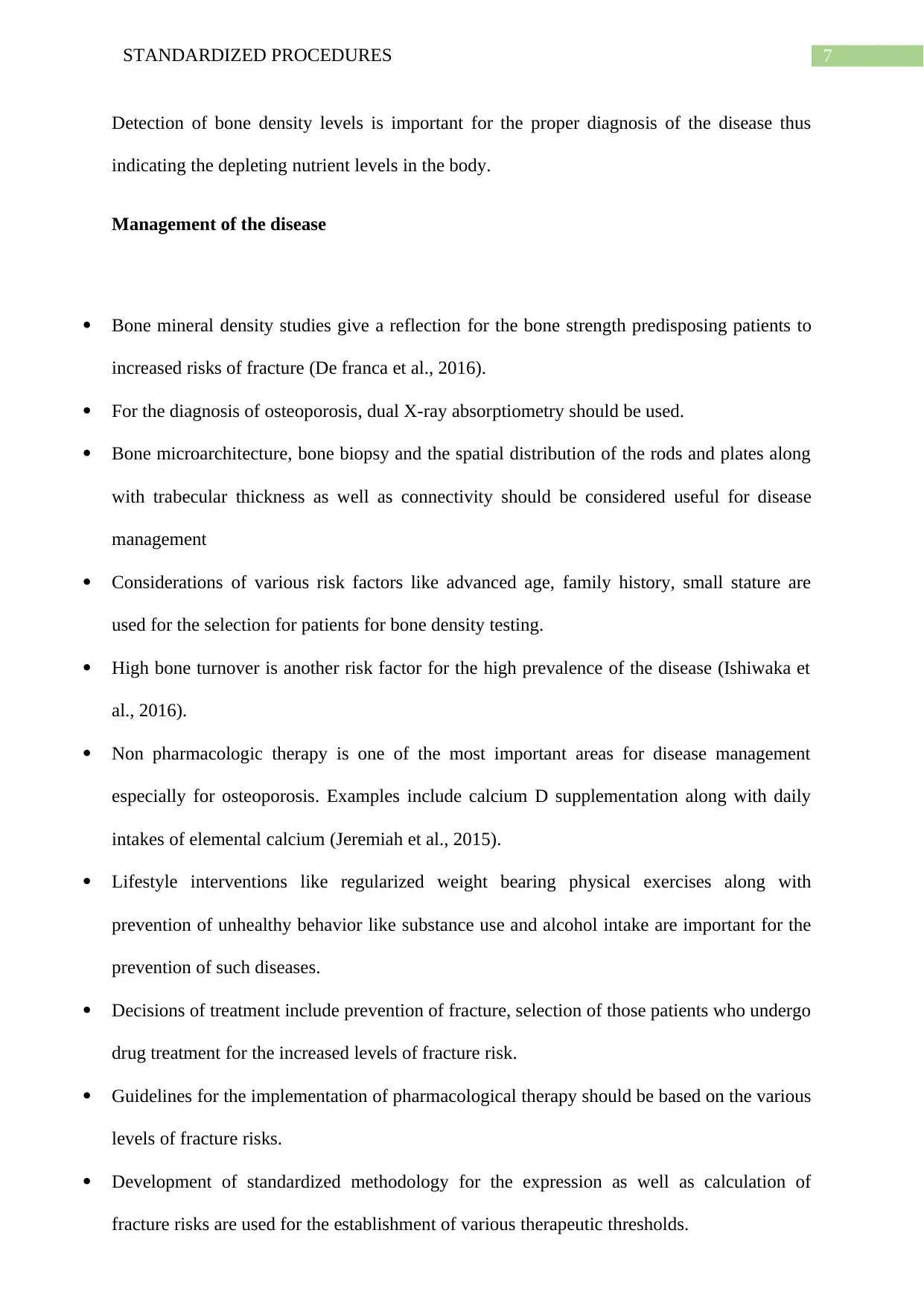
7STANDARDIZED PROCEDURES
Detection of bone density levels is important for the proper diagnosis of the disease thus
indicating the depleting nutrient levels in the body.
Management of the disease
Bone mineral density studies give a reflection for the bone strength predisposing patients to
increased risks of fracture (De franca et al., 2016).
For the diagnosis of osteoporosis, dual X-ray absorptiometry should be used.
Bone microarchitecture, bone biopsy and the spatial distribution of the rods and plates along
with trabecular thickness as well as connectivity should be considered useful for disease
management
Considerations of various risk factors like advanced age, family history, small stature are
used for the selection for patients for bone density testing.
High bone turnover is another risk factor for the high prevalence of the disease (Ishiwaka et
al., 2016).
Non pharmacologic therapy is one of the most important areas for disease management
especially for osteoporosis. Examples include calcium D supplementation along with daily
intakes of elemental calcium (Jeremiah et al., 2015).
Lifestyle interventions like regularized weight bearing physical exercises along with
prevention of unhealthy behavior like substance use and alcohol intake are important for the
prevention of such diseases.
Decisions of treatment include prevention of fracture, selection of those patients who undergo
drug treatment for the increased levels of fracture risk.
Guidelines for the implementation of pharmacological therapy should be based on the various
levels of fracture risks.
Development of standardized methodology for the expression as well as calculation of
fracture risks are used for the establishment of various therapeutic thresholds.
Detection of bone density levels is important for the proper diagnosis of the disease thus
indicating the depleting nutrient levels in the body.
Management of the disease
Bone mineral density studies give a reflection for the bone strength predisposing patients to
increased risks of fracture (De franca et al., 2016).
For the diagnosis of osteoporosis, dual X-ray absorptiometry should be used.
Bone microarchitecture, bone biopsy and the spatial distribution of the rods and plates along
with trabecular thickness as well as connectivity should be considered useful for disease
management
Considerations of various risk factors like advanced age, family history, small stature are
used for the selection for patients for bone density testing.
High bone turnover is another risk factor for the high prevalence of the disease (Ishiwaka et
al., 2016).
Non pharmacologic therapy is one of the most important areas for disease management
especially for osteoporosis. Examples include calcium D supplementation along with daily
intakes of elemental calcium (Jeremiah et al., 2015).
Lifestyle interventions like regularized weight bearing physical exercises along with
prevention of unhealthy behavior like substance use and alcohol intake are important for the
prevention of such diseases.
Decisions of treatment include prevention of fracture, selection of those patients who undergo
drug treatment for the increased levels of fracture risk.
Guidelines for the implementation of pharmacological therapy should be based on the various
levels of fracture risks.
Development of standardized methodology for the expression as well as calculation of
fracture risks are used for the establishment of various therapeutic thresholds.
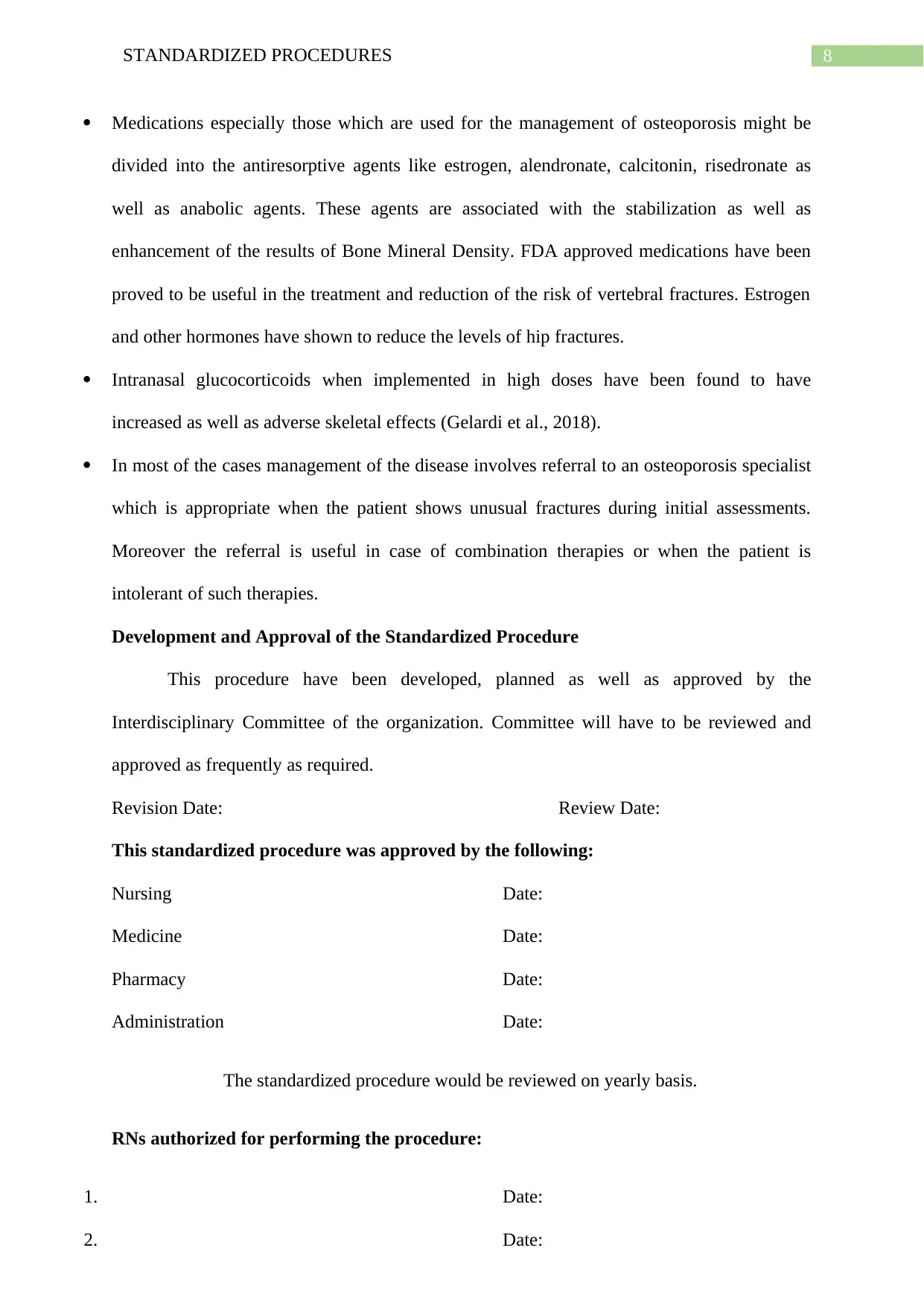
8STANDARDIZED PROCEDURES
Medications especially those which are used for the management of osteoporosis might be
divided into the antiresorptive agents like estrogen, alendronate, calcitonin, risedronate as
well as anabolic agents. These agents are associated with the stabilization as well as
enhancement of the results of Bone Mineral Density. FDA approved medications have been
proved to be useful in the treatment and reduction of the risk of vertebral fractures. Estrogen
and other hormones have shown to reduce the levels of hip fractures.
Intranasal glucocorticoids when implemented in high doses have been found to have
increased as well as adverse skeletal effects (Gelardi et al., 2018).
In most of the cases management of the disease involves referral to an osteoporosis specialist
which is appropriate when the patient shows unusual fractures during initial assessments.
Moreover the referral is useful in case of combination therapies or when the patient is
intolerant of such therapies.
Development and Approval of the Standardized Procedure
This procedure have been developed, planned as well as approved by the
Interdisciplinary Committee of the organization. Committee will have to be reviewed and
approved as frequently as required.
Revision Date: Review Date:
This standardized procedure was approved by the following:
Nursing Date:
Medicine Date:
Pharmacy Date:
Administration Date:
The standardized procedure would be reviewed on yearly basis.
RNs authorized for performing the procedure:
1. Date:
2. Date:
Medications especially those which are used for the management of osteoporosis might be
divided into the antiresorptive agents like estrogen, alendronate, calcitonin, risedronate as
well as anabolic agents. These agents are associated with the stabilization as well as
enhancement of the results of Bone Mineral Density. FDA approved medications have been
proved to be useful in the treatment and reduction of the risk of vertebral fractures. Estrogen
and other hormones have shown to reduce the levels of hip fractures.
Intranasal glucocorticoids when implemented in high doses have been found to have
increased as well as adverse skeletal effects (Gelardi et al., 2018).
In most of the cases management of the disease involves referral to an osteoporosis specialist
which is appropriate when the patient shows unusual fractures during initial assessments.
Moreover the referral is useful in case of combination therapies or when the patient is
intolerant of such therapies.
Development and Approval of the Standardized Procedure
This procedure have been developed, planned as well as approved by the
Interdisciplinary Committee of the organization. Committee will have to be reviewed and
approved as frequently as required.
Revision Date: Review Date:
This standardized procedure was approved by the following:
Nursing Date:
Medicine Date:
Pharmacy Date:
Administration Date:
The standardized procedure would be reviewed on yearly basis.
RNs authorized for performing the procedure:
1. Date:
2. Date:
⊘ This is a preview!⊘
Do you want full access?
Subscribe today to unlock all pages.

Trusted by 1+ million students worldwide
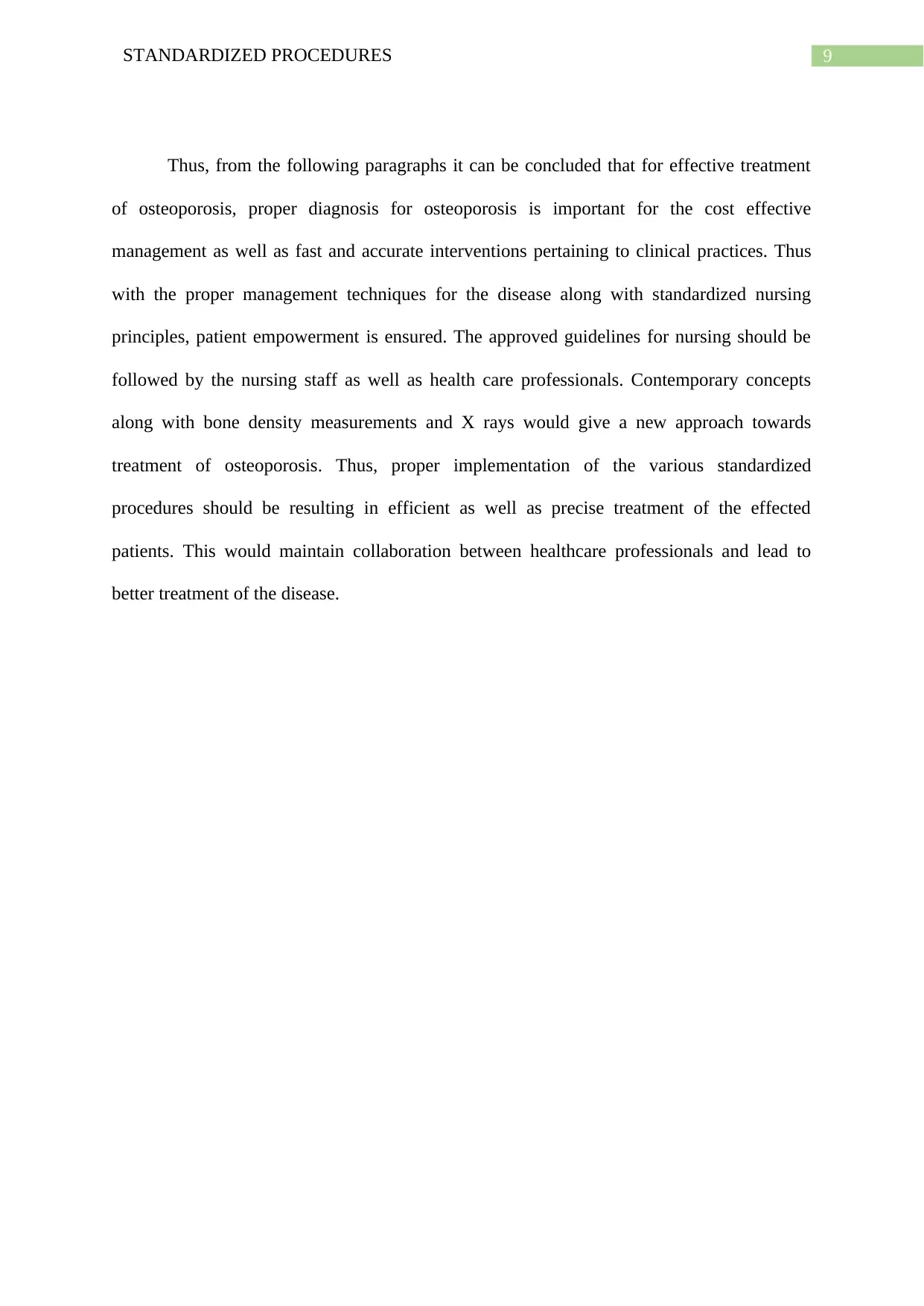
9STANDARDIZED PROCEDURES
Thus, from the following paragraphs it can be concluded that for effective treatment
of osteoporosis, proper diagnosis for osteoporosis is important for the cost effective
management as well as fast and accurate interventions pertaining to clinical practices. Thus
with the proper management techniques for the disease along with standardized nursing
principles, patient empowerment is ensured. The approved guidelines for nursing should be
followed by the nursing staff as well as health care professionals. Contemporary concepts
along with bone density measurements and X rays would give a new approach towards
treatment of osteoporosis. Thus, proper implementation of the various standardized
procedures should be resulting in efficient as well as precise treatment of the effected
patients. This would maintain collaboration between healthcare professionals and lead to
better treatment of the disease.
Thus, from the following paragraphs it can be concluded that for effective treatment
of osteoporosis, proper diagnosis for osteoporosis is important for the cost effective
management as well as fast and accurate interventions pertaining to clinical practices. Thus
with the proper management techniques for the disease along with standardized nursing
principles, patient empowerment is ensured. The approved guidelines for nursing should be
followed by the nursing staff as well as health care professionals. Contemporary concepts
along with bone density measurements and X rays would give a new approach towards
treatment of osteoporosis. Thus, proper implementation of the various standardized
procedures should be resulting in efficient as well as precise treatment of the effected
patients. This would maintain collaboration between healthcare professionals and lead to
better treatment of the disease.
Paraphrase This Document
Need a fresh take? Get an instant paraphrase of this document with our AI Paraphraser

10STANDARDIZED PROCEDURES
References
Au, M. L., Sao Lo, M., Cheong, W., Wang, S. C., & Van, I. K. (2016). Nursing students'
perception of high-fidelity simulation activity instead of clinical placement: A
qualitative study. Nurse education today, 39, 16-21.
Benjamin, B., Benjamin, M. A., Swe, M., & Sugathan, S. (2016). Review on the comparison
of effectiveness between denosumab and bisphosphonates in post-menopausal
osteoporosis. Osteoporosis and sarcopenia, 2(2), 77-81.
Black, D. M., & Rosen, C. J. (2016). Postmenopausal osteoporosis. New England Journal of
Medicine, 374(3), 254-262.
De França, N. A. G., Camargo, M. B. R., Lazaretti-Castro, M., Peters, B. S. E., & Martini, L.
A. (2016). Dietary patterns and bone mineral density in Brazilian postmenopausal
women with osteoporosis: a cross-sectional study. European journal of clinical
nutrition, 70(1), 85.
Gelardi, M., Barbara, F., Covelli, I., Damiani, M. A., Plantone, F., Notarnicola, A., ... &
Ciprandi, G. (2018). Long-Term Therapy with Corticosteroids in Nasal Polyposis: A
Bone Metabolism Assessment. Indian Journal of Otolaryngology and Head & Neck
Surgery, 1-7.
Halpern, Y., Horng, S., Choi, Y., & Sontag, D. (2016). Electronic medical record
phenotyping using the anchor and learn framework. Journal of the American Medical
Informatics Association, 23(4), 731-740.
Ishikawa, K., Nagai, T., Sakamoto, K., Ohara, K., Eguro, T., Ito, H., ... & Inagaki, K. (2016).
High bone turnover elevates the risk of denosumab-induced hypocalcemia in women
with postmenopausal osteoporosis. Therapeutics and clinical risk management, 12,
1831.
References
Au, M. L., Sao Lo, M., Cheong, W., Wang, S. C., & Van, I. K. (2016). Nursing students'
perception of high-fidelity simulation activity instead of clinical placement: A
qualitative study. Nurse education today, 39, 16-21.
Benjamin, B., Benjamin, M. A., Swe, M., & Sugathan, S. (2016). Review on the comparison
of effectiveness between denosumab and bisphosphonates in post-menopausal
osteoporosis. Osteoporosis and sarcopenia, 2(2), 77-81.
Black, D. M., & Rosen, C. J. (2016). Postmenopausal osteoporosis. New England Journal of
Medicine, 374(3), 254-262.
De França, N. A. G., Camargo, M. B. R., Lazaretti-Castro, M., Peters, B. S. E., & Martini, L.
A. (2016). Dietary patterns and bone mineral density in Brazilian postmenopausal
women with osteoporosis: a cross-sectional study. European journal of clinical
nutrition, 70(1), 85.
Gelardi, M., Barbara, F., Covelli, I., Damiani, M. A., Plantone, F., Notarnicola, A., ... &
Ciprandi, G. (2018). Long-Term Therapy with Corticosteroids in Nasal Polyposis: A
Bone Metabolism Assessment. Indian Journal of Otolaryngology and Head & Neck
Surgery, 1-7.
Halpern, Y., Horng, S., Choi, Y., & Sontag, D. (2016). Electronic medical record
phenotyping using the anchor and learn framework. Journal of the American Medical
Informatics Association, 23(4), 731-740.
Ishikawa, K., Nagai, T., Sakamoto, K., Ohara, K., Eguro, T., Ito, H., ... & Inagaki, K. (2016).
High bone turnover elevates the risk of denosumab-induced hypocalcemia in women
with postmenopausal osteoporosis. Therapeutics and clinical risk management, 12,
1831.

11STANDARDIZED PROCEDURES
Jeremiah, M. P., Unwin, B. K., Greenawald, M. H., & Casiano, V. E. (2015). Diagnosis and
management of osteoporosis. Am Fam Physician, 92(4), 261-268.
Jonasson, G., & Rythen, M. (2016). Alveolar bone loss in osteoporosis: a loaded and cellular
affair?. Clinical, cosmetic and investigational dentistry, 8, 95.
Lake, E. T., Germack, H. D., & Viscardi, M. K. (2016). Missed nursing care is linked to
patient satisfaction: a cross-sectional study of US hospitals. BMJ Qual Saf, 25(7),
535-543.
Lei, J., Wen, D., Zhang, X., Li, J., Lan, H., Meng, Q., & Sittig, D. F. (2017). Enabling health
reform through regional health information exchange: a Model Study from
China. Journal of healthcare engineering, 2017.
Leslie, W. D., & Morin, S. N. (2014). Osteoporosis epidemiology 2013: implications for
diagnosis, risk assessment, and treatment. Current opinion in rheumatology, 26(4),
440-446.
Rare causes of osteoporosis. Clinical Cases in Mineral and Bone Metabolism, 12(2), 151..
Rn.ca.gov. (2019). Retrieved from http://www.rn.ca.gov/pdfs/regulations/npr-b-20.pdf
Ryu, K. J., Park, H. T., Kim, Y. J., Yi, K. W., Shin, J. H., Hur, J. Y., & Kim, T. (2016).
Vasomotor symptoms and osteoporosis in Korean postmenopausal
women. Maturitas, 87, 27-32.
Sheu, A., & Diamond, T. (2016). Diagnostic tests: Bone mineral density: testing for
osteoporosis. Australian prescriber, 39(2), 35.
Shin, H., Sok, S., Hyun, K. S., & Kim, M. J. (2015). Competency and an active learning
program in undergraduate nursing education. Journal of Advanced Nursing, 71(3),
591-598.
Jeremiah, M. P., Unwin, B. K., Greenawald, M. H., & Casiano, V. E. (2015). Diagnosis and
management of osteoporosis. Am Fam Physician, 92(4), 261-268.
Jonasson, G., & Rythen, M. (2016). Alveolar bone loss in osteoporosis: a loaded and cellular
affair?. Clinical, cosmetic and investigational dentistry, 8, 95.
Lake, E. T., Germack, H. D., & Viscardi, M. K. (2016). Missed nursing care is linked to
patient satisfaction: a cross-sectional study of US hospitals. BMJ Qual Saf, 25(7),
535-543.
Lei, J., Wen, D., Zhang, X., Li, J., Lan, H., Meng, Q., & Sittig, D. F. (2017). Enabling health
reform through regional health information exchange: a Model Study from
China. Journal of healthcare engineering, 2017.
Leslie, W. D., & Morin, S. N. (2014). Osteoporosis epidemiology 2013: implications for
diagnosis, risk assessment, and treatment. Current opinion in rheumatology, 26(4),
440-446.
Rare causes of osteoporosis. Clinical Cases in Mineral and Bone Metabolism, 12(2), 151..
Rn.ca.gov. (2019). Retrieved from http://www.rn.ca.gov/pdfs/regulations/npr-b-20.pdf
Ryu, K. J., Park, H. T., Kim, Y. J., Yi, K. W., Shin, J. H., Hur, J. Y., & Kim, T. (2016).
Vasomotor symptoms and osteoporosis in Korean postmenopausal
women. Maturitas, 87, 27-32.
Sheu, A., & Diamond, T. (2016). Diagnostic tests: Bone mineral density: testing for
osteoporosis. Australian prescriber, 39(2), 35.
Shin, H., Sok, S., Hyun, K. S., & Kim, M. J. (2015). Competency and an active learning
program in undergraduate nursing education. Journal of Advanced Nursing, 71(3),
591-598.
⊘ This is a preview!⊘
Do you want full access?
Subscribe today to unlock all pages.

Trusted by 1+ million students worldwide
1 out of 13
Related Documents
Your All-in-One AI-Powered Toolkit for Academic Success.
+13062052269
info@desklib.com
Available 24*7 on WhatsApp / Email
![[object Object]](/_next/static/media/star-bottom.7253800d.svg)
Unlock your academic potential
Copyright © 2020–2025 A2Z Services. All Rights Reserved. Developed and managed by ZUCOL.





